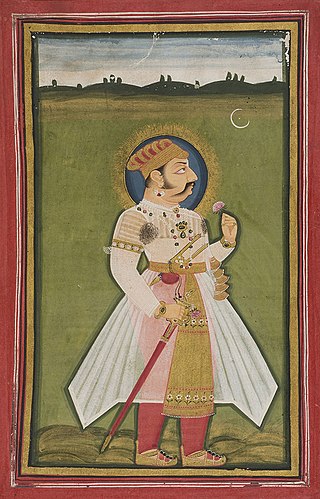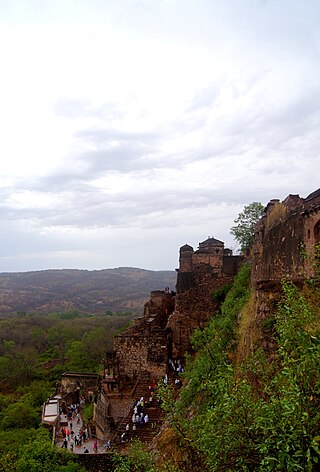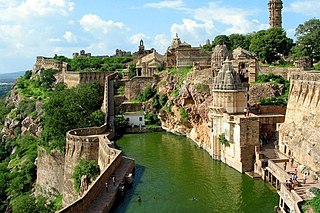
Several significant battles are recorded to have taken place in what is now known as Rajasthan.

Several significant battles are recorded to have taken place in what is now known as Rajasthan.
The Guhilas were feudatories of the Moriyas of Chitor and they came into prominence in the time of Khummaņa I popularly known as Bappā Rāwal who was the 9th ruler in the family of Guhadatta. He started his political career as a vassal of the Mori monarch Manurāja and probably led the Mori forces against the Arabs. In this expedition, Bappā Rāwal achieved complete victory. [7]

Rajasthan is a state in northwestern India. It covers 342,239 square kilometres (132,139 sq mi) or 10.4 per cent of India's total geographical area. It is the largest Indian state by area and the seventh largest by population. It is on India's northwestern side, where it comprises most of the wide and inhospitable Thar Desert and shares a border with the Pakistani provinces of Punjab to the northwest and Sindh to the west, along the Sutlej-Indus River valley. It is bordered by five other Indian states: Punjab to the north; Haryana and Uttar Pradesh to the northeast; Madhya Pradesh to the southeast; and Gujarat to the southwest. Its geographical location is 23°.3' to 30°.12' North latitude and 69°.30' to 78°.17' East longitude, with the Tropic of Cancer passing through its southernmost tip.

The Rajputana Agency was a political office of the British Indian Empire dealing with a collection of native states in Rajputana, under the political charge of an Agent reporting directly to the Governor-General of India and residing at Mount Abu in the Aravalli Range. The total area of the states falling within the Rajputana Agency was 127,541 square miles (330,330 km2), with eighteen states and two estates or chiefships.

Nagaur is a city and municipal council in Nagaur district of the state of Rajasthan in India. It is the administrative headquarters of Nagaur District. The Nagaur city lies about midway between Jodhpur and Bikaner.

Marwar is a region of western Rajasthan state in North Western India. It lies partly in the Thar Desert. The word 'maru' is Sanskrit for desert. In Rajasthani languages, "wad" means a protected area. English translation of the word 'marwar' is the region protected by desert.

Ajit Singh Rathore was the ruler of Marwar region in the present-day Rajasthan and the son of Jaswant Singh Rathore.

Rao Maldeo Rathore was a king of the Rathore dynasty, who ruled the kingdom of Marwar in present day state of Rajasthan. Maldeo ascended the throne in 1531 CE, inheriting a small ancestral principality of Rathore's but after a long period of military actions against his neighbours, Maldeo swept significant territories which included parts of present day Rajasthan, Haryana, Uttar Pradesh, Gujarat and Sindh. He refused to ally with either the Sur Empire or the Mughal Empire.

Rao JodhaRathore was the 15th Rajput chief of Rathore clan who ruled the Kingdom of Marwar in the present-day state of Rajasthan. He was the fifth son of Rao Ranmal. He is known for his illustrious military career and for founding the city of Jodhpur in 1459, which subsequently became the new capital of Marwar after Mandore.

Rana Kumbha or Kumbhkaran Singh (1433–1468), popularly known as Maharana Kumbha, was the ruler of the Kingdom of Mewar. He belonged to the Sisodia clan of Rajputs. It was during his reign that Mewar became one of the most powerful political powers in northern India. He is considered to be the most powerful ruler of his time in India.

Ranthambore Fort lies within the Ranthambore National Park, near the city of Sawai Madhopur in Sawai Madhopur district of Rajasthan, India. the park being the former hunting grounds of the Maharajahs of Jaipur until the time of India's Independence. It is a formidable fort having been a focal point of the historical developments of Rajasthan. The fort is believed to be constructed by numerous kings from Several Dynasties including The Yadavas, Chahamana Rajputs, Hada Rajputs, Mewar Rajput Kings and then the Delhi Sultanate captured it for a brief time. The fort provides a panoramic view of the surrounding Ranthambore National Park and is now a popular tourist attraction.

The history of human settlement in the western Indian state of Rajasthan dates back to about 100,000 years ago. Around 5000 to 2000 BCE many regions of Rajasthan belonged as the site of the Indus Valley Civilization. Kalibangan is the main Indus site of Rajasthan, here fire altars have been discovered, similar to those found at Lothal.

The Kingdom of Mewar, also called Medapata, was an independent kingdom that existed in the Rajputana region of the Indian Subcontinent and later became a dominant state in medieval India. The kingdom was initially founded and ruled by the Guhila dynasty followed by the Sisodiya Dynasty. The earliest kingdom was centered around the south-central part of Rajasthan, state of India. It was bordered by the Aravali Range to the northwest, Ajmer to the north, Gujarat, Vagad and Malwa regions to the south and the Hadoti region to the east.

Kingdom of Marwar, also known as the Jodhpur State under the British, was a kingdom in the Marwar region from 1243 to 1818 and a princely state under British rule from 1818 to 1947. It was established in Pali by Rao Siha, possibly a migrant Gahadavala noble, in 1243. His successors continued to struggle against regional powers for domination and 9 out of 15 rulers till 1438 died in combat. In 1395, its capital was changed to Mandore by Rao Chunda of Mandore and to Jodhpur in 1459 by Rao Jodha.
The Mughal–Rajput wars were a series of battles between the Rajput Confederacy and the Mughal Empire. The conflicts originated with the invasion of northwestern India by the Mughal ruler Babur, to which the head of the Rajput confederacy, Rana Sanga, offered staunch resistance.
The history of human settlement in the west Indian state of Rajasthan dates back to about 5,000 years ago.

Mahmud Khalji (1436–1469), also known as Mahmud Khilji and Ala-ud-Din Mahmud Shah I, was the Sultan of Malwa, in what is now the state of Madhya Pradesh, India. Khilji came into power after assassinating Mohammad, the son of the previous ruler, Hoshang Shah, in 1435. He mounted an unsuccessful campaign against the Delhi Sultanate however, it was under his reign that the Malwa Sultanate reached its greatest height.
Rao Ranmal, also called Ran Mal or Ridmal, was the Rathore ruler of Marwar. A notable expansionist and skilled warrior, Ranmal is also noteworthy for having twice served as regent of the kingdom of Mewar under two different kings.

The Mewar- Malwa conflict was a series of wars between the Kingdom of Mewar and the Islamic Sultanate of Malwa. The conflict erupted due to mutual territorial expansion triggered by both sides on each other. The war was fought in what is now known as the Indian states of Rajasthan and Madhya Pradesh. The Rana branch of the Guhilas, following their successful recovery of the Rajput stronghold of Chittorgarh and the entire region of Mewar alongside Rajputana after the Battle of Singoli, embarked on an ambitious expansion at the cost of their neighboring kingdoms. On the other side, with the invasion of Timur, the Lame Delhi Sultanate grew weak with its multiple subahs gaining independence which included Malwa, adjacent to Mewar.
The Conquest of Ajmer was a military expedition launched by the Sultan Mahmud Khalji of Malwa aimed to conquer and subdue the region of Mewar, which was under the control of the Mewar kingdom.This military expedition was undertaken against Mewar with the intention of seeking revenge from Rana Kumbha of Mewar. It was a major military conquest carried out during the reign of Mahmud Khalji with the goal of expanding territorial control. Although Mahmud was victories in this campaign, he was not able to hold Ajmer for a longer period of time. As it was later reconquered by Rana Kumbha.

The Conquest of Mandalgarh was a military expedition led by Sultan Mahmud Khalji of Malwa against Mewar. The primary objective of this campaign was to capture the Mandalgarh fort, which was under the command of Uparamal, a subordinate of Rana Kumbha. Mahmud Khalji marched towards Mewar in the year 1457 to achieve this goal.

The Siege of Chittorgarh was a pivotal moment in Sher Shah Suri's efforts to expand his influence in the region. By targeting the strategic Chittor Fort, he aimed to solidify his control over Rajputana and establish his authority in the area. The campaign was characterized by intense military tactics and strategic planning, as Sher Shah Suri sought to overcome the formidable defenses of the fort. The siege of Mewar showcased Sher Shah Suri's prowess as a military leader and highlighted his determination to assert his dominance in Rajasthan. The success of this conquest further solidified his reputation as a formidable ruler in the region.
Dulha Rai left Gwalior around AD 1071 and entered the territory of Dhundhar, subdued the Badgujars and Minas and settled at Dausa
Bisaldev successfully repulsed a large Ghaznavid army led by Sultan Khusrau Shah (1152-1160), which had advanced as far as Vavvera....He wrested Delhi from the Tomars in either AD 1151 or 1153, but allowed them to continue to hold the area as Chauhan Feudatories. He also took Hansi (Asika) from the Ghaznavids
"In 592/1195-96 Muizzuddin again carme to India. He attacked Bayana, which was under Kumarapala, a Jadon Bhatti Rajput. The ruler avoided a confrontation at Bayana, his capital, but went to Thankar and entrenched himself there. He vas, howvever, compelled to surrender. Thankar and Vijayamandirgarh were occupied and put under Bahauddin Tughril. Mu'izzuddin - next marched towards Gwalior. Sallakhanapala of the Parihara dynasty, however, acknowledged the suzerainty of Muizzuddin
Lakshman Simha is said to have defeated the Sultan of Delhi near Badnor and got exemption from the pilgrimage tax imposed on the Hindus for their visits to holy places like Kashi, Gaya and Paryag
The battle of Dewar was fought in a valley of Arvali about 40 km north -east of Kumbhalgarh. ... Prince Amar Singh fought valiantly and pierced through Sultan Khan and the horse he was riding.
{{citation}}: CS1 maint: location missing publisher (link)Prince Pravez and Asaf Khan led an army of 20,000 horse which fought a battle against Rana Amar Singh at Dewar
In January 1718, Jai Singh wrote to the Emperor that Churaman, despite his being reduced to hard suaits. was not inclined to yield, as he was receiving support from the Court. Indeed, Churaman had offered a present of twenty lakhs of Rupees to Saiyid Abdullah Khan and a peshkash of thirty lakhs of Rupees to the Government, in case the campaign was called off. Abdullah Khan saw in the offer an opportunity to bring discredit to Jai Singh, and to win over the Jats to his side. He, therefore, represented to tire Emperor that when Churaman was willing to submit and to attend the Court with his sons and nephews, there was no point in continuing the siege which had already dragged on for about twenty months and had cost the exchequer a good deal of money. t-o To the conditions on which Churaman's submission was to be accepted, the Emperor now added two more the dismantling of the fortifications of Thun, Deeg and other forts, which were not to be rebuilt in future, and service by Churaman and his sons and nephews, in subah Agra.To Farrukhsiyar it must have appeared right to call off the campaign on these terms which fulfilled the main objective with which it was undertaken
in a pitched battle at Mandan, both sides suffered heavily. Peero Khan died and Mitra Sen fled the field, leaving the Shekhawat chiefs victorious.